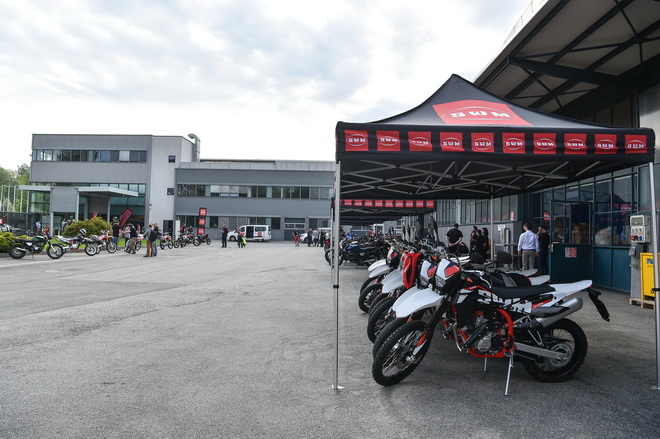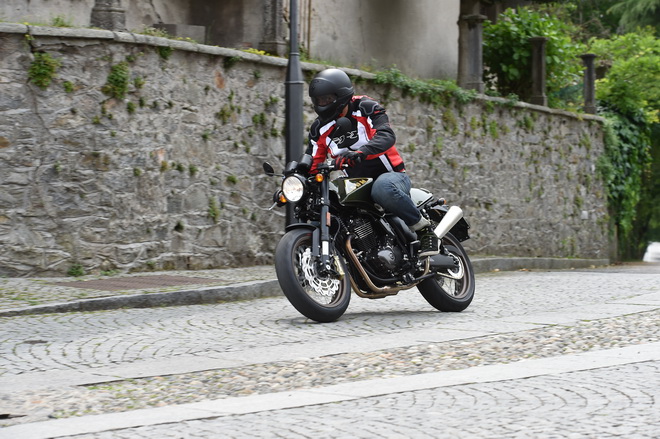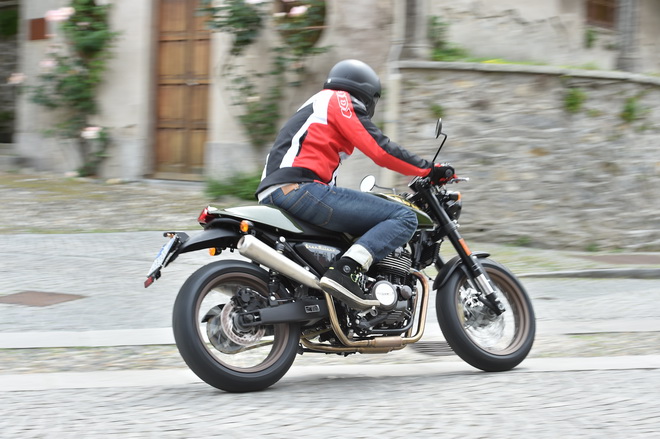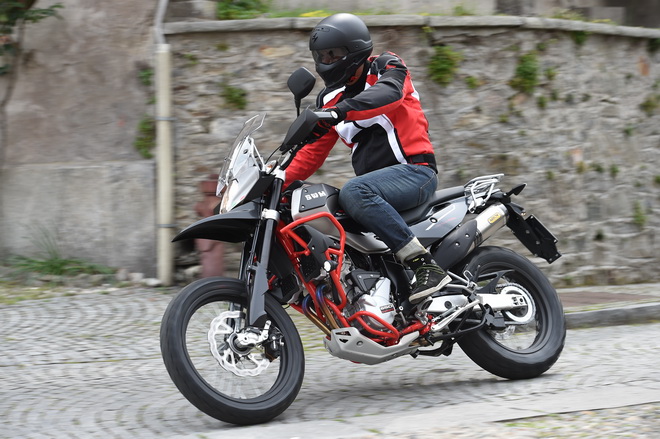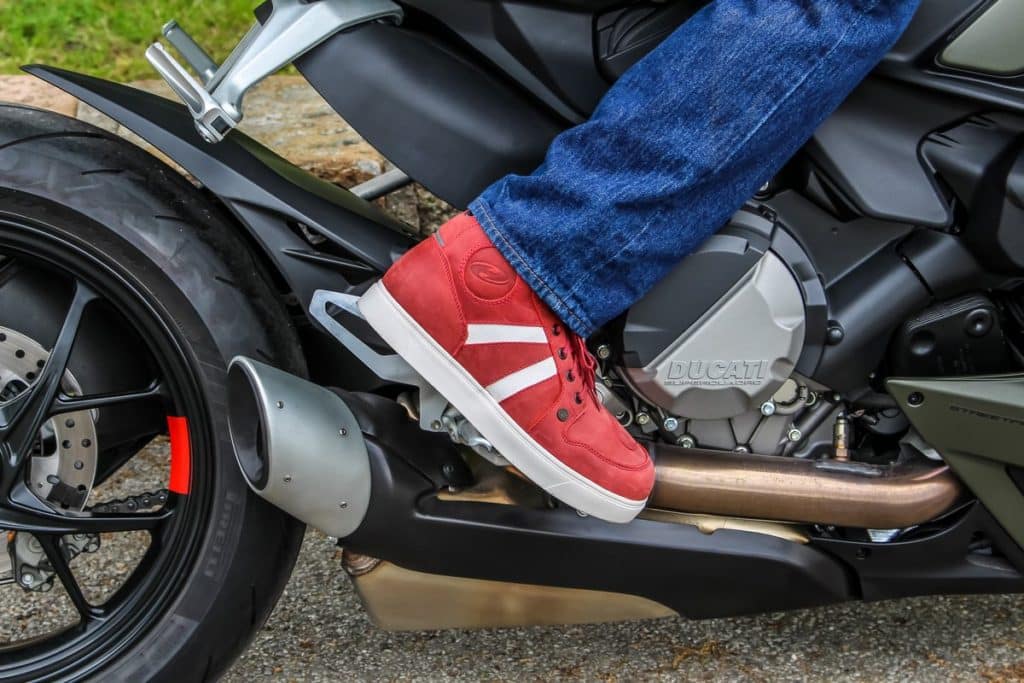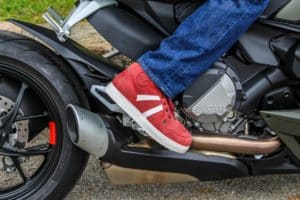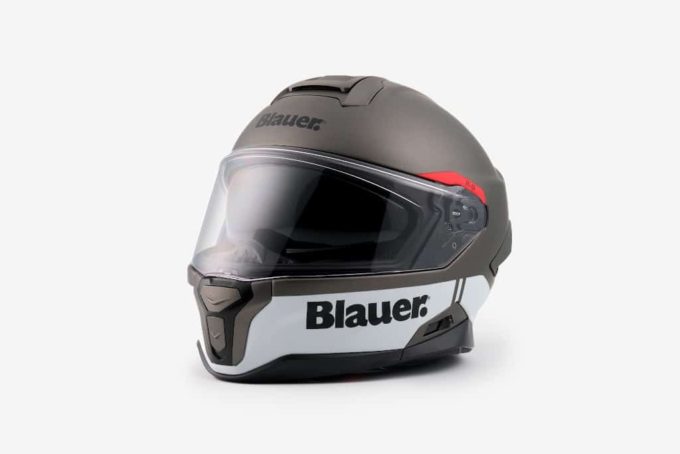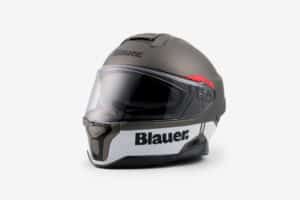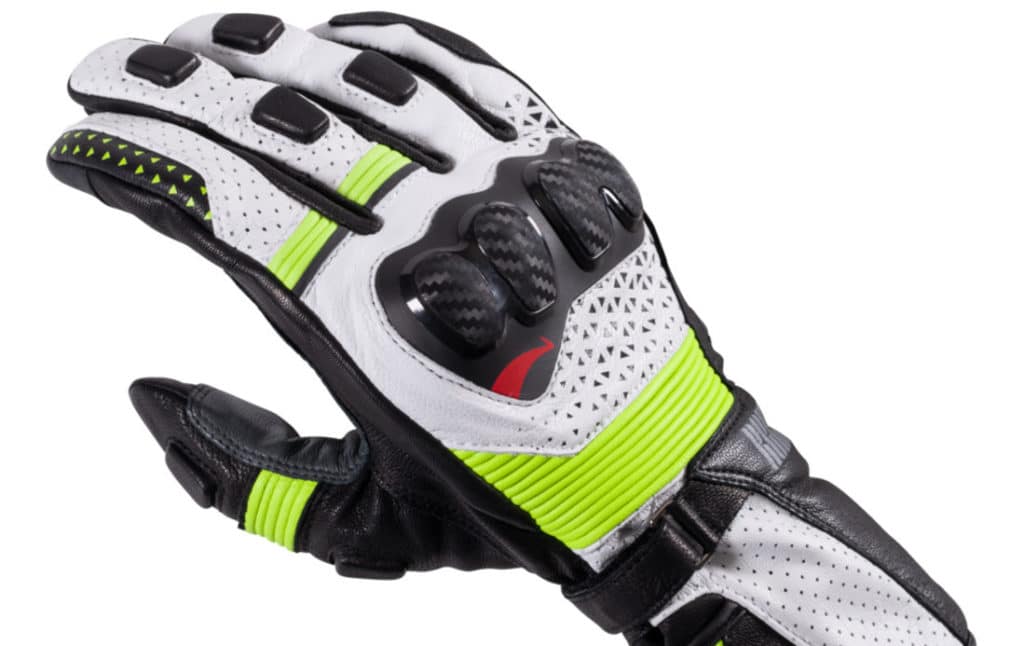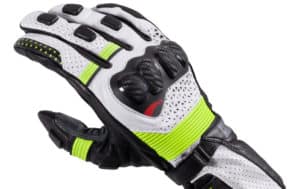SWM, test ride of the 2017 range [ROAD TEST]
The historic Italian brand is attempting to relaunch with Chinese capital
SWM range 2017 – In Biandronno, in the province of Varese, the group of journalists present for the international press test is large, around 150 people. This is a grand relaunch, which has some points of contact with the one underway for another historic Italian company, Benelli. In both cases, the style and history of a company from the Bel Paese merge with the capital of powerful China, increasingly at the center of the global economy. It is not for nothing that the location chosen to welcome colleagues from all over the world is impressive, it is in fact the Ville Ponti Congress Center in Varese, with a 56.000 square meter park in English style and the very elegant Villa Andrea dominating the complex.
An important brand, a location equally linked to the history of Italian two-wheelers
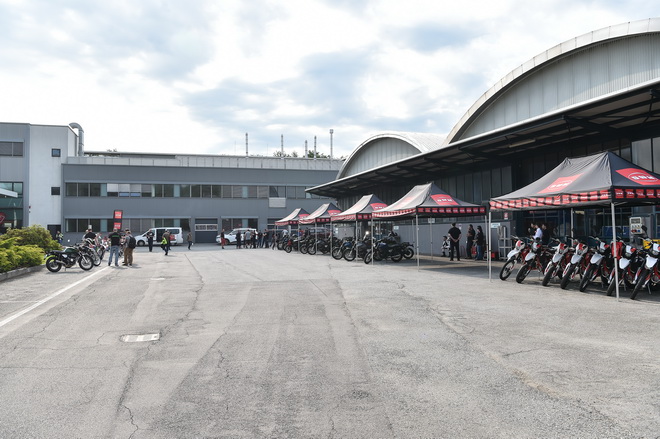
SWM, for those who don't know it, is a reality that was born from the idea of two enthusiasts, Fausto Vergani and Pietro Sironi, to compete with the best off-road motorcycles of the time. It had a rather short history, from 1971 to 1984, during which its motorbikes, strictly two-stroke (Sachs and Rotax the most frequently used engines), achieved some important successes in competitions, from Regularity to Cross and also in the Trial. SWM can in fact be remembered above all for being the first Italian company to win a World Championship in this specialty in 1981. Historically the headquarters were in Palazzolo Milanese, while the 3 letters of the brand are an acronym for Speedy Working Motors. One of the two founding members, Pietro Sironi, tried to continue the activities, renaming it SVM (Società Veicoli Milanese), but without having great success and definitively closing its doors in 1987. The second piece that leads to today is more recent and linked to a another brand, Husqvarna. Swedish motorcycle company which, it seems by chance, was acquired by Cagiva in the same year in which SWM definitively ceased operations, which led to moving production to the Cassinetta di Biandronno factories. The recent history is more recent, with the parenthesis under the BMW Group from 2007 to 2013 and the subsequent transition to KTM, which closed the Italian plants, leaving around 200 employees without a job, but also freeing the historic headquarters. Here we return to the relaunch of SWM, which began in 2014 and in which Ampelio Macchi, an engineer with a past at Aprilia first, but then at Cagiva and Husqvarna, played a central role. Thanks to him, who was able to reach an agreement with the Chinese financial group Shineray, SWM has a second opportunity today.
The relaunch focuses on a wide range right from the start, developed over three years and which goes in both directions, that of a past linked to competitions, with models closer to racing and off-road use, such as the RS in 125 engine capacity, 300 and 500, or the SM (125 or 500 available), but also the more strictly commercial one, with an eye on emerging markets, as well as historical ones like ours. Here we find the Superdual, the Gran Milano, the Gran Turismo and the Silver Vase, a model that takes the name of one of the most famous 1976 motorbikes produced by SWM.
After a "theoretical" presentation on the evening of our arrival, the following day we had the opportunity to see the entire range of motorbikes live. Under 4 separate gazebos we were able to see all the models currently present in the price list and, we must admit, there are quite a few (also considering their color variations).
Under the first gazebo we find "the small" RS 125 R and SM 125 R in two colours, red and black. These motorbikes are the entry level motorbikes, for all those kids who still harbor a passion for "real" motorbikes, complete with gearbox and clutch, and who are looking for a product that can give them emotions and sensations worthy of a motorbike. In the second Gazebo there are the more specialized and mean RS 300 R and RS 300 R Flat Track, RS 500 R and SM 500 R. These bikes are of a decidedly higher range than the previous ones, especially in the 500 cc version, they are destined to pilots who already have some experience. The larger RS 650 R is also present but, even speaking with the technicians, we understand that it is the 500 cc versions that are the most "pushed". The 650 version is the one best suited to road use, thanks to the greater cubic capacity it manages to be less exaggerated and therefore more usable in daily use, while remaining a decidedly technical motorbike.
The third gazebo is entirely dedicated to what, in our opinion, is the model that will probably have the most appeal in Italy, namely the SUPERDUAL. This motorbike is present in different versions which are the GT version, the T version and the around 4 horsepower, but also available in a detuned version for new drivers equipped with A600.
The last gazebo, the fourth, instead welcomes the "classic" family, all sharing the same starting point, but with characteristics that differentiate them from each other. They all have a 4 cc single-cylinder 445-stroke engine, but it is their standard equipment that sets them apart. The 3 models are respectively the Silver Vase, the Gran Turismo and the Gran Milano, with the latter destined to be the top of the range in the classic category. For obvious reasons of numbers, understood both as journalists present at the launch (we are talking about over 120 people from each country) and models, we were asked to select two models with which to carry out the road test. We decided to focus on two of the most usable and interesting proposals: the Gran Milano and the Superdual, the bikes that in our opinion will have the greatest appeal to the Italian public.
We start the test with the Gran Milano which, it is worth remembering, is sold with a double saddle (single and two-seater) and we begin the tour around Lake Varese with the semi-handlebars in our hands. The first impression, which will be confirmed during the test, is that of an "easy" motorcycle intended for a wide audience. The riding position is classic "cafè racer", with the torso generally lying on the tank, but it's nothing that can bother you. It can be driven well through the medium-slow curves of the state roads surrounding the lake and the Varesina company, with an engine that whirrs happily. The bike as a whole is an object that does not require great effort to be ridden but, perhaps, the small mono 445 should have had a little more liveliness, to be able to play less with the gearbox and more with the gas between one bend and the next. other. In fact, among the various ups and downs, we often found ourselves having to change gear to maintain a "cheerful" pace. The gearbox has always complied with our requests, jamming is rare (perhaps also due to the very few kilometers traveled by the bikes), but it would have been more pleasant to have an engine with more brilliant performance, especially in the first part of the power range. In fact, being a single cylinder, if you use it high the vibrations increase considerably and the thrust weakens rapidly. It is therefore advisable to change gear and play with the analogue rev counter needle, to stay in that range in which the small mono can give its best.
During the test of the Gran Milano, being in the same group as the classics, we also had the opportunity to do a few kilometers on the Silver Vase and the Gran Turismo. The technical configuration is the same, as already mentioned, but the Silver Vase has a scrambler setup, with knobby wheels and specific measurements (the front is 19″) and decidedly higher handlebars, especially compared to the clip-on handlebars of the Great Milan. The Gran Turismo is exactly halfway between the two, with wide handlebars, but without the crossbar of the Silver Vase, low exhausts, unlike the tall ones of the Silver, and more road tyres, while maintaining the 19" front. The braking of all three bikes is entrusted to two discs, of which the front one is 320 mm, with a classic caliper for the Silver Vase and Gran Turismo versions, while the Gran Milano has a petal front brake and radial mount caliper. The double front disc is not missing, given the speed of the bikes and the style they are designed for. Aesthetics won over function, but without sacrificing anything in terms of safety. A 24-litre tank and Pirelli MT-120 tires (70/150 at the front and 60/17 at the rear, with 60" rims) complete the picture. The numbers instead speak of a torque of 36 Nm at 5.500 rpm, while the power is around 30 horsepower and the weight of only 145 kg, in running order (but without fuel).
Change of pace instead with the Superdual, equipped with the 600 cc single-cylinder engine, 4 valves derived from Husqvarna, which with its 57 horsepower, combined however with a weight of only 169 kg (always in running order, but without fuel) makes it However, it makes it agile and agile in the face of those who, instead, focus entirely on large displacements.
The little mono whips happily and the ride, compared to the classic ones, immediately becomes more lively. The “Fast Ace” is the front telehydraulic fork with upside down legs and advanced pivot, with hydraulic brake adjustment in extension and 45 mm legs. At the rear the Sachs is of the progressive "Soft Damp" type, with hydraulic monoshock, spring preload and hydraulic brake adjustment in compression (double) and rebound. 300 mm brake disc at the front and 220 at the rear, again with ABS as standard.
In the GT version the weight of the bags and the various superstructures (paramotor with additional lights and higher fairing) almost seem to want to distort the real vocation of this motorbike, even if, however, as we will verify during the test, they make its use decidedly wider . Being a single-cylinder, continuous use at constant speed is certainly not recommended, the vibrations are still felt, but it is a motorbike that can easily be used for daily home-office commuting without however precluding a trip out of town on the weekend. A brilliant motorbike, which allows everyone to have fun at an affordable price.
The foundations are there, we'll see if it will be a success
The rebirth of the SWM brand, in the factory that was Husqvarna (whose production has been moved abroad), can only be seen well by an Italian, also for the jobs it guarantees and which we hope will also increase. The products are there, of course they are now very simple, designed to be essential, with little electronics, but also little weight, as we have seen. They still deserve some refinement, for example we noticed a fairly accentuated "on-off" and perhaps thanks to the measures for Euro 4 approval, which could be smoothed out in the next updates. The challenge is a tough one, nowadays it is not easy to make numbers in the motorcycle field, but large Chinese capital and strictly Italian passion could bear fruit. For now the goal for 2017 is to reach 7 motorbikes sold.
Prices
The bikes on test, Gran Milano and Superdual, have prices of 5.990 and 7.490 respectively for the Superdual in the X version. The version equipped with GT PACK (bags, engine guard with spotlights and fairing) costs 8.390 euros. All prices ex-dealership.
Test clothing:
Jacket: Spidi Tronik Tex
Pants: Spidi J-Strong
Gloves: Spidi S-4
Shoe: Stylmartin
Helmet: Scorpion EXO-Combat
if you want to always be updated on our news
Follow us here












